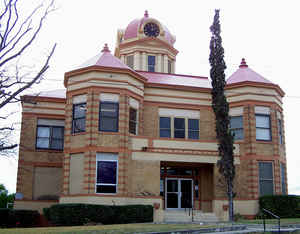Texas Counties
Texas is divided into two hundred and fifty-four counties, more than any other state. Texas was originally divided into municipalities, a unit of local government under Spanish and Mexican rule. When the Republic of Texas gained its independence in 1836, there were 23 municipalities, which became the original Texas counties. Many of these would later be divided into new counties. The most recent county to be created was Kenedy County in 1921. The most recent county to be organized was Loving County in 1931Kinney County, Texas
Kinney County Education, Geography, and History

Kinney County is a county located in the state of Texas. Based on the 2010 census, its population was 3,598. Its county seat is Brackettville. The county was created in 1850 and later organized in 1874. It is named for Henry Lawrence Kinney, an early settler.
Etymology - Origin of Kinney County Name
Henry Lawrence Kinney, an unsuccessful land speculator
Demographics:
County QuickFacts: CensusBureau Quick Facts
Kinney County History
First inhabitants were 6,000-10,000 years ago and later came to include Lipan Apache, Mescalaro Apache, Coahuiltecan,
Jumanos, Tamaulipans, Tonkawa and Comanches. These tribes settled in rockshelters in the river and creek valleys, leaving behind artifacts and
caches of seeds, implements, burial sites, and petroglyphs.
Saltillo alcalde Fernando de Azcué in 1665 passed through the southeast corner of the county on an expedition, becoming the first European to
cross the Rio Grande. Franciscan Brother Manuel de la Cruz explored the county in 1674. In 1675, Fernando del Bosque traversed the area on an
expedition up the Rio Grande from the city of Nuestra Sra. de Guadalupe. He was accompanied by the Franciscan Friars Juan Larios and Dionisio
de San Buenaventura. Alonso De León in 1688 discovered French explorer and La Salle expedition deserter Jean Henri in a somewhat confused
state of mind, among the Coahuiltecan Indians near the site of present Brackettville, generally believed to be at Anacacho Mountain. During
the latter eighteenth century, several Franciscans established a settlement on Las Moras Creek near the center of the county. In 1834, English
land speculators John Charles Beales and James Grant attempted to establish an English-speaking colony called Dolores at the site. Streets
were laid off and fifty-nine colonists were brought in, but the project was abandoned.
The state legislature formed Kinney County from Bexar County in 1850 and named it for Henry Lawrence Kinney. The United States Army
established Fort Clark in June 1852 on Las Moras Creek, and named it after John B. Clark, who had died in the Mexican War. Brackettville was
founded in 1852 originally as the town of Brackett and named for Oscar B. Brackett, who came to set up a stage stop and opened the town's
first dry-goods store. Brackett became a stop on a stage line from San Antonio to El Paso, but the settlement grew very slowly because of
continuous Indian attacks. The town received its first post office in 1875. On February 18, 1861, on orders from United States Army General
David E. Twiggs, Fort Clark was surrendered to the Texas Commission. Twiggs was dismissed by the United States for the act, and subsequently
joined the Confederacy. The fort was evacuated by federal troops on March 19 and occupied by Confederate troops under the command of
Confederate Colonel John R. Baylor. It remained in the hands of the Confederates until the end of the war, but was not garrisoned. In December
1866 it was reestablished as a federal fort.
In the early 1872 a number of Black Seminole Indians living along the border were organized into a company of scouts and brought to Fort
Clark. Others joined them, and by the mid-1870s they numbered some 400 or 500. For the next quarter century they lived on a reservation along
Las Moras Creek. In 1914 the Black Seminoles were removed from the Fort Clark reservation, but some of their descendants still live in the
county. The Seminole Indian Scouts cemetery was founded on Fort Clark in 1872.
The county was organized in 1874. County government followed in 1875. In 1876, Brackettville was designated county seat after the final
boundaries of the county were set by the legislature.
Handbook of Texas Online
In the early 1870s a number of Black Seminole Indians living along the border were organized into a company of
scouts and brought to Fort Clark. Others joined them, and by the mid-1870s they numbered some 400 or 500. For the
next quarter century they lived on a reservation along Las Moras Creek. In 1914 the Black Seminoles were removed
from the Fort Clark reservation, but some of their descendants still live in the county. By 1874 the population was
large enough for the county to be formally organized, and by 1875 the first county government was in place. In 1876
Brackettville was designated county seat after the final boundaries of the county were set by the legislature. The
1870s brought numerous signs that the county was slowly losing its frontier character. The first school, started by
Margaret Martin Ballantyne, began operating around 1870, and a post office was opened in 1873. The first church, St.
Mary Magalene's, was organized in 1875, and the Gilead Church, a Black Seminole church, was established in the late
1870s. More at
Christopher Long, "KINNEY COUNTY," Handbook of Texas Online (http://www.tshaonline.org/handbook/online/articles/hck09),
accessed January 24, 2016. Uploaded on June 15, 2010. Published by the Texas State Historical Association.
Geography: Land and Water
As reported by the Census Bureau, the county has a total area of 1,365 square miles (3,536 km2), of which,
1,363 square miles (3,531 km2) of it is land and 2 square miles (5 km2) of it (0.14%) is water.
Neighboring Counties
Bordering counties are as follows:
- Edwards County (north)
- Uvalde County (east)
- Maverick County (south)
- Val Verde County (west)
- Jim?ez, Coahuila, Mexico (southwest)
Education







